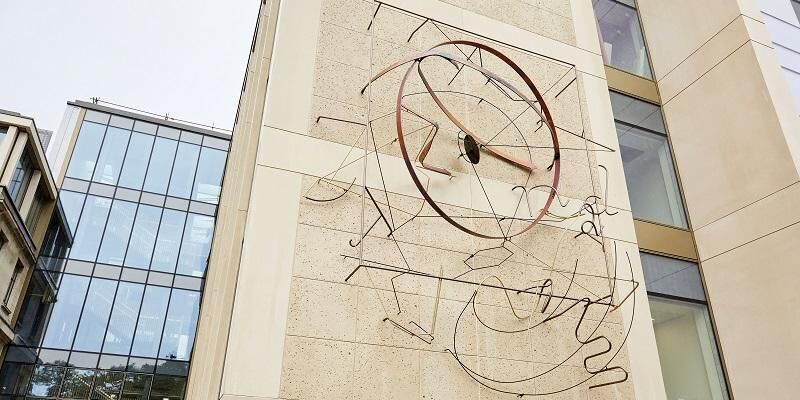
A large sculpture has been installed on the side of the Sir William Henry Bragg building, a new engineering and physical sciences development at the University.
By artist Sara Barker, the installation is made from light-weight welded aluminium and a variety of shapes, motifs and colours convey ideas linked to science and engineering – and make connections with Leeds as a former centre of the textile industry and as a creative city.
The artwork measures seven metres by just over six metres and is positioned more than four metres above the ground.
“Sara Barker's striking artwork is a vibrant reminder of the Nobel Prize winning contribution of the Braggs.”
The artist has used iridescent paints inspired by research at the University, which allows parts of the structure to take on a different colour depending on the angle it is viewed from.
Barker said: “It felt it was like a real opportunity to try something different in my work, a curve ball that might activate or completely transform the work in different lighting, while representing in some sense the powerful and creative crossovers between specialisms that happen all the time amongst academics and scientists in the building.
“I want the work to sit between the qualities of drawing, collage, textile, painting and sculpture, and its meaning and derivation to be correspondingly subjective and open to our interpretation.”
Honouring Sir William Henry Bragg
The building is named after Sir William Henry Bragg, whose pioneering research at the University in the early 1900s won a Nobel prize and unlocked some of the biggest discoveries in modern science.
As people walk around the sculpture, the symbols that represent that research are gradually revealed – the Bragg equation: nλ = 2 d sin θ.
The artwork is titled The Worlds of If – a reference to the possibilities that open up when scientists and engineers work together and share ideas. That philosophy of collaboration will underpin research in the new building, on topics such as the development of new materials, more energy-efficient computing devices and drug discovery. It will also house laboratories and teaching spaces.
Sir Alan Langlands, Vice-Chancellor, said: "Sara Barker's striking artwork is a vibrant reminder of the Nobel Prize winning contribution of the Braggs in 'the analysis of crystal structures by means of X-rays' and the power of science in shaping modern society.
“The Sir William Henry Bragg Building will provide state of the art facilities to support ground-breaking interdisciplinary research, spanning engineering, physical sciences and computing, and linking with colleagues in medicine and biology. The Bragg Centre for Materials Research will discover, create and design new materials which will translate to a wide range of industrial settings.
“Critically, this new complex will also provide creative spaces for students, ensuring that their research-based education is enriched by having access to cutting edge laboratories, workshops and digital facilities."
Launch of a scientific revolution
Sir William Henry Bragg was the Cavendish Professor of Physics at the University from 1909 to 1915. He conducted research with his son, William Lawrence Bragg.
Listen to scientist and historian Dr Kersten Hall describe the contribution the Braggs made to science.
Scientists in Germany had already discovered that a beam of X-rays is diffracted or bends as it passes through a crystal. The Braggs realised that they could work backwards from that finding. By measuring how the X-rays scattered, they would be able to reveal the atomic structure of the crystal. That research resulted in the Bragg Equation – and a technique called X-ray crystallography.
Nearly 40 years after the Braggs received the Nobel prize, X-ray crystallography became part of the scientific investigations that have revealed the double-helix shape of DNA and revolutionised the understanding of molecular biology.
Dr Kersten Hall, a Visiting Fellow at the University, is both a scientist and historian of science.
He said: “The work that the Braggs did at Leeds was massively significant. To date, 28 Nobel prizes have been won using that technique that they developed – X-ray crystallography. Thanks to that method, scientists have been able to work out the shape of medically important compounds such as the antibiotic penicillin and the hormone insulin.
“But perhaps most famously at all, their method of X-ray crystallography helped scientists to unravel the structure of DNA, the genetic molecule and its helical structure which explains how it passes on genetic information from one generation to the next.”
Art for the public to enjoy
The Worlds of If joins the extensive range of public art on the University of Leeds campus. Public art enhances the experience of students, staff, local communities and visitors, and reflects the academic research themes and learning activities of University life. Other artworks on the Public Art Trail include Barbra Hepworth’s Dual Form and Henry Moore’s Three Piece Reclining Figure No2: Bridge Prop. Download the Public Art Trail to discover more.
Sara Barker trained at the Glasgow School of Art, painting department in 2003, where she now teaches. She currently has a solo exhibition at Leeds Art Gallery until the end of September 2020. Her forthcoming solo exhibition at Cample Line, Dumfriesshire, opens in October 2020.